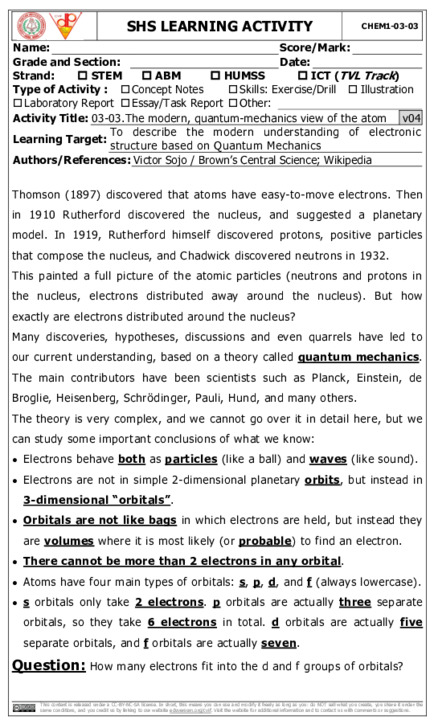Downloads
- Click on the image above to download this LAS as a PDF file.
- You can also download all the Chemistry 1 LASs together in a long PDF.
- Alternatively, you can download the DOCX file with all the original Chemistry LASs, which you can freely modify to your needs within the terms of our CC-BY-NC-SA license.
Purposes
- This LAS seeks to introduce electronic structure in the view of Quantum Mechanics.
- The theory is extremely complex and its details are out of the scope of the course, so the intention here is only to summarize the main ideas, including wave-particle duality, and the existence of orbitals.
- Another important idea introduced is Pauli’s exclusion principle: there can be no more than 2 electrons in the same orbital.
Answers to questions
- There are 5 d sub-orbitals in each group of d orbitals, so 2 electrons in each gives 10 electrons maximum.
- Similarly, 7 f sub-orbitals allows for 14 electrons maximum.
Discussion
- The three most important ideas in this LAS are:
- 1. Orbitals are not like defined planetary orbits. They are volumes, but not like bags. They are fuzzy volumes of where it is likely to find an electron.
- 2. Never more than 2 electrons in any orbital, ever! This is Pauli’s exclusion principle.
- 3. Atoms have four main types of orbitals: s, p, d and f. The simplest orbital is the s, which fits 2 electrons. p orbitals can fit 6 electrons, but this is not a violation of Pauli’s exclusion principle. This is because p orbitals are actually 3 sub-orbitals. d orbitals fit 10 electrons because there are 5 d sub-orbitals, and f orbitals can fit 14 electrons because they’re actually 7 sub-orbitals.
Advanced information
- Although the consequence of Pauli’s exclusion principle is very simple, its causes are far from trivial.
- Try to avoid going into this discussion at this level, but if students ask, try to tell them that it has something to do with something called “spin”. Put simply (and not entirely correctly), electrons can either spin one way (say eastwards, like the Earth, technically spin +½) or the other (westwards, or spin –½).
- In an orbital, the first electron can take one spin, the second takes the other, and a third electron will have to go somewhere else.
- If you have extremely keen and well informed students, you can tell them that this is because electrons have a half spin (plus or minus ½), but since photons have an integer spin, you can have many of them with the same quantum state, which is why we can have lasers!
References and authors
References
- Brown et al. The Central Science, 14th Ed. Pearson. ISBN:978-1292221229.
- Wikipedia: Pauli exclusion principle.
Authors and contributors
This LAS was developed by Dr. Victor Sojo, with helpful contributions from Dr. Christopher Bernido, Dr. Marivic Bernido and Ms. Jea Mae Rances.
If you have any questions or comments, please leave them below.
